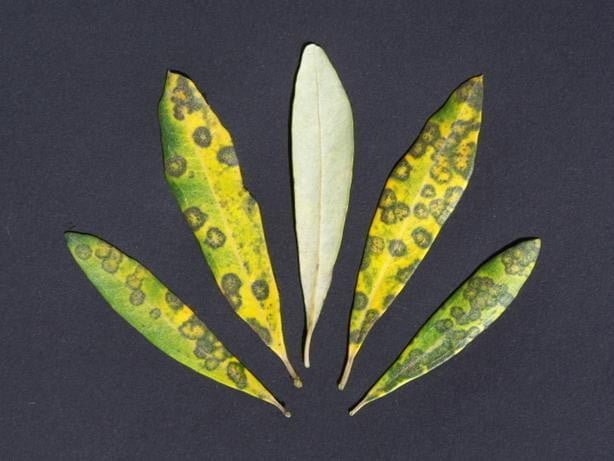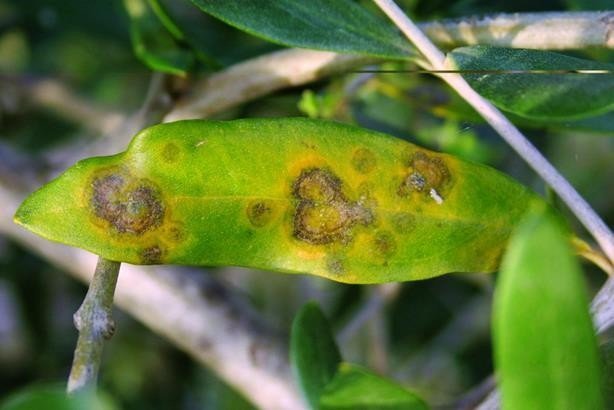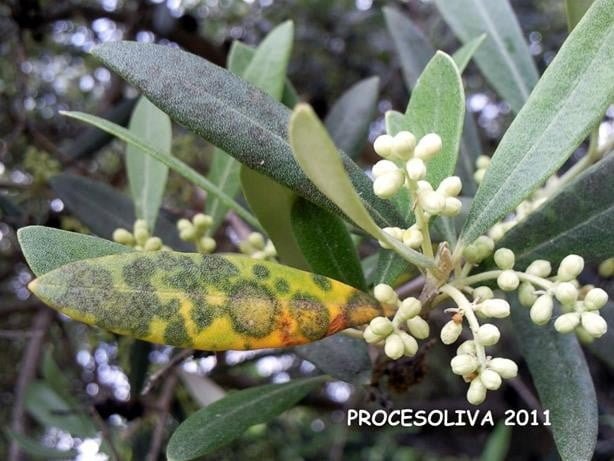Table of contents of the article
ToggleOlive leaf spot disease is one of the common problems that affect the health and productivity of olive trees.in this article on your website botanist WORLD of PLANTS, we will review the causes, symptoms and control methods of maintaining the health of olive trees.
- Name of the disease: Marinating olive leaves
- English name: Spot Leaf Olive
- Scientific name: Spilocaea oleagina
- Type of disease: Fungal disease
- The platoon: Venturiaceae
Symptoms of olive leaf spot disease
- Olive leaf spot disease, also known as Peacock spots or bird's eye spots, is characterized by the appearance of circular or irregular spots on the leaves of olive trees.
- These spots are initially small, yellowish-green or yellowish-brown in color, with a dark brown or black center.
- As the disease progresses, the spots may widen and merge, forming larger spots.
- In severe cases, premature shedding of the leaves of the tree can occur, which leads to a decrease in photosynthesis and fruit production.



Causes of olive leaf spot disease
- This disease is caused by the fungus Spilocaea oleagina.
- The fungus ferments into infected leaves on the tree or on the ground and produces spores that can infect new leaves and shoots in spring and summer.
Conditions of spread of olive leaf spot disease
- Olive leaf spot disease prefers warm, humid conditions and long periods of leaf wetness.
- The spores of the fungus are spread by wind, rain or spray irrigation, which allows them to spread from infected plants to healthy ones.
- The disease can also be spread by contaminated pruning tools or plant material.
- Factors that promote dense crown growth such as excessive nitrogen fertilization or improper pruning increase the severity of the disease by creating a humid living environment inside the tree.
Losses of olive leaf spot disease
- Olive leaf spotting can significantly reduce the yield of olives due to premature leaf shedding, which hinders photosynthesis and fruit development.
- In severe cases, the disease can weaken the tree and make it more susceptible to stresses such as drought or pests, which ultimately leads to deterioration or death of the tree.
Strategy for combating olive leaf spot disease
- An integrated approach that includes such agricultural practices as pruning to improve ventilation, avoiding excessive nitrogen fertilizing, proper disposal of infected plant residues, helps to combat olive leaf spot.
- Fungicidal sprays simultaneous with the course of the disease may also be necessary in severe cases.
Preventive measures for olive leaf spot disease
- Preventive measures include proper pruning to enhance ventilation, avoiding sprinkling irrigation over the treetops, removal and destruction of infected plant material.
- The use of resistant or tolerant olive varieties of the disease can also help reduce its occurrence and severity.
Organic/chemical control of olive leaf spot disease
- For organic control, copper-based fungicides, such as copper hydroxide or copper oxychloride, can be used as preventive or exterminating treatments.
- These copper compounds have antimicrobial properties and can help suppress the growth of mushrooms.
- Biocontrol agents, such as certain strains of bacteria Bacillus subtilis, have also shown promising results in reducing the severity of olive leaf spotting.
In conventional agriculture, synthetic fungicides such as trifluoxystrobin, peraclostrobin or diphenoconazole may be used for chemical control.
In conclusion, we would like to note that we, at the world of plants website, offer you all the necessary services in the world of plants, we provide all farmers and those interested in plants with three main services::-
- Artificial intelligence consulting service to help you identify diseases that affect plants and how to deal with them.
- Blog about plants, plant diseases and care of various crops ... You are currently browsing one of her articles right now.
- An application that provides agricultural consultations to clients, as well as a service for imaging diseases and knowing their treatment for free – Click to download the Android version from Google Play Store، Click to download the IOS version from the Apple App Store.




